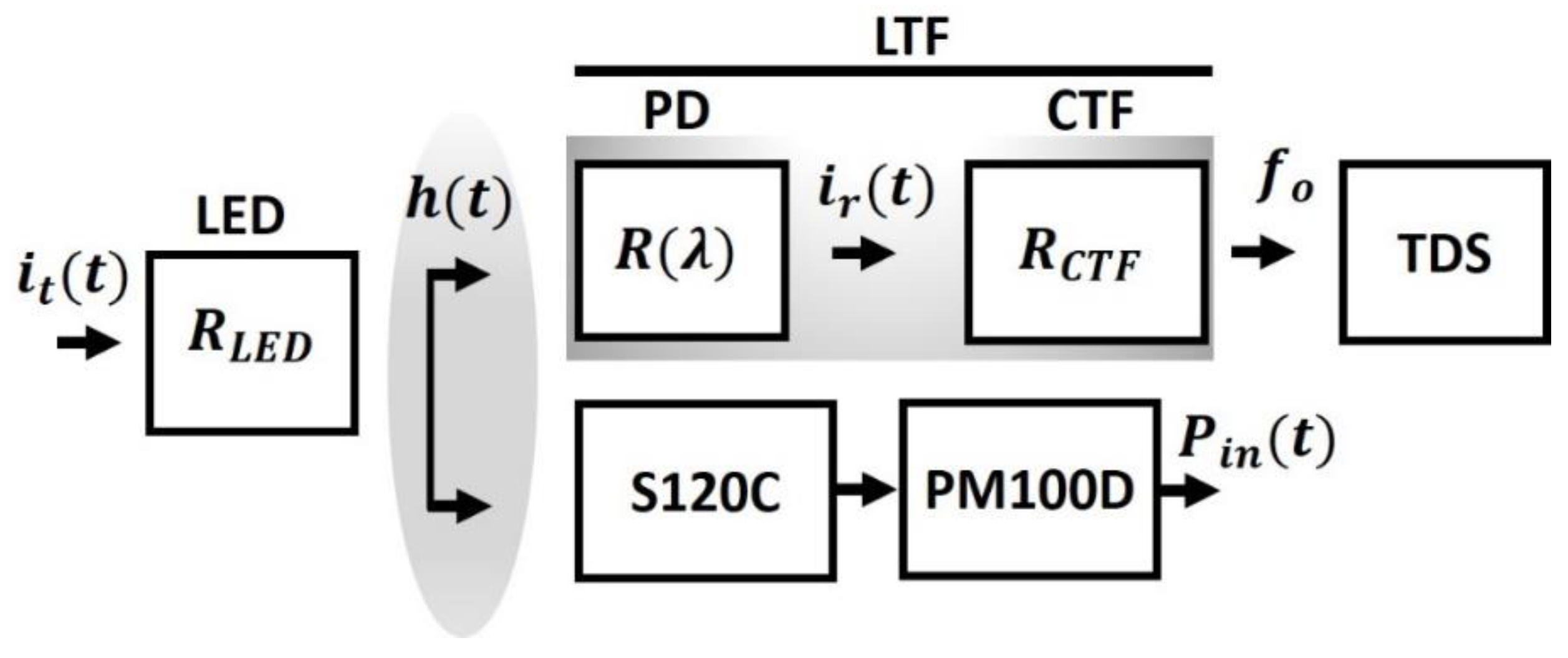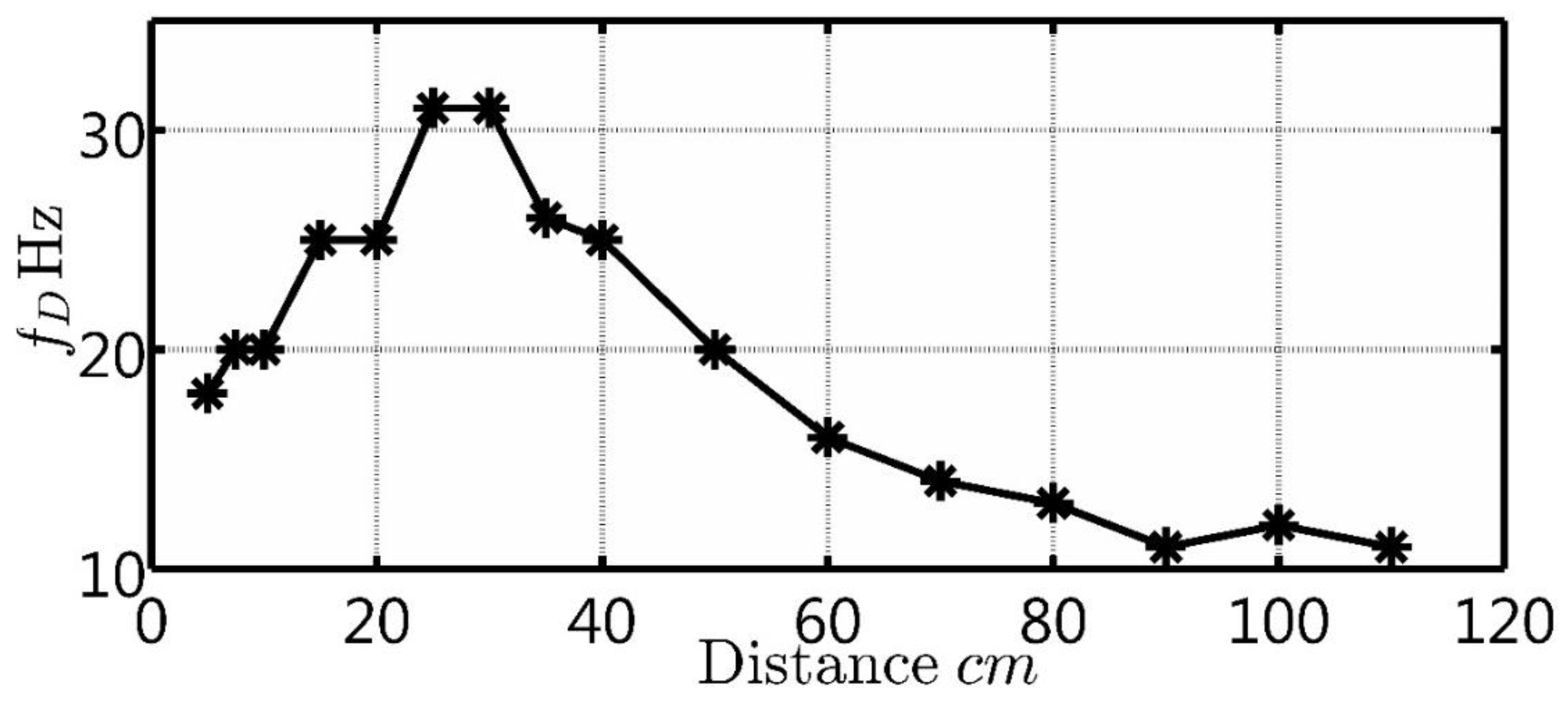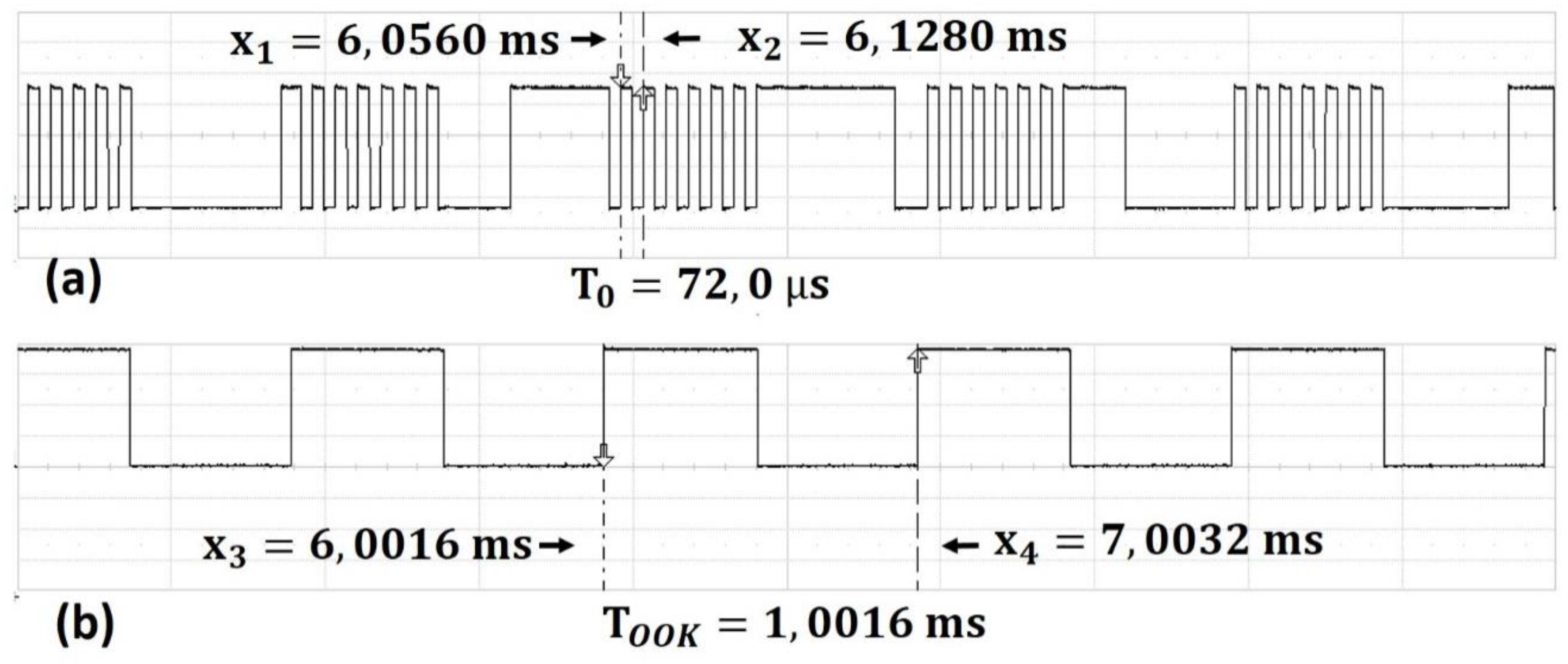1. Introduction
In optical wireless communication (OWC), it is common to find optical receivers conformed by positive intrinsic negative (PIN) photodiodes or avalanche photodiode (APD) and analog-to-digital converters (ADC) [
1,
2,
3,
4,
5,
6], as proposed by the IEEE 802.15.7 standard [
7] for visible light communication (VLC) systems. Among these, the PIN photodiodes (PD) are presented more often in VLC systems, because they have better immunity to noise and low parasitic capacitance, and can be used to speed up the transmission (ultrafast PIN-PD), which is a milestone in VLC works [
2,
6]. This is a result of the intrinsic material between the p–n junction, which leads to a reduction of the time constant, and thus better bandwidth [
2,
8]. In fact, the PIN-type photodiodes adapted to the red-green-blue (RGB) sensors have been studied for applications in VLC systems [
9], the authors characterized these sensors and determined its frequency response. Furthermore, PIN photodiodes are being adapted to other systems, to perceive intensity levels of light and turn over periodic electrical signals with frequencies that correspond to the incident power in the photodetector [
10]. These devices are known as light-to-frequency (LTF) converters, and are internally comprised of PIN-type photodiodes and a module that transforms the photocurrent to frequency. The mentioned module employs a voltage-controlled oscillator (VCO), which reduces and simplifies the conditioning circuit of the photodiode, allowing its adaptation with embedded low-cost systems that do not require ADC [
10,
11,
12,
13,
14,
15,
16]. Therefore, the LTF converters are exposed as an attractive solution for the detection of communication signals in the visible range of the electromagnetic spectrum because of the reduction of the system complexity [
10]. Recently, LTF converters have been investigated, for example, in optical communication systems for the design of portable transceivers [
11] and in health applications to detect levels of oxygen in the blood [
12], among others.
In this paper, we propose the use of a light-to-frequency converter as an alternative to design the receiver of a VLC system. In this scheme, the characterization and performance evaluation of LTF converter as a receiver in a VLC system, based on on-off keying (OOK) modulation, is presented. The main contribution of this article is summarized as follows: initially, the characterization of an LTF converter is presented, and an equation is derived based on both the incident optical power and the frequency generated in the LTF, in order to estimate the system’s SNR value. The second contribution is the evaluation of the LTF by using a periodic optical signal, which reveals the advantages and disadvantages regarding its use as a receiver in a VLC system.
The rest of the paper is organized as follows:
Section 2 shows the model of the VLC system and the LTF converter. The characterization of the LTF converter for a VLC system is presented in
Section 3. The results and discussions are presented in
Section 4. Finally, we summarize the main conclusions.
3. Characterization of the LTF for a VLC System
In this section, we present the characterization of the LTF converter and the analysis of the proposed VLC.
In particular, an EMC 3030 HV white light LED, Tektronix TDS 3034C oscilloscope, THORLABS PM100D instrument and an LTF TCS3200 were used for the experimental setup, as shown in
Figure 2. In the TCS3200, the light-to-frequency converter reads an array of 8 × 8 photodiodes with 16 photodiodes with blue filters, 16 with red filters, 16 with green filters, and the remaining 16 photodiodes are clear with no filters. For this experimental setup, the TCS3200 device was configured for its maximum output frequency and only the blue channel was used for the VLC system as the blue component of a white LED lighting has the highest bandwidth [
18,
19,
20]. Given the nature of the proposed experiment, it is necessary to bear in mind that the central wavelength of the blue filter in the LTF is
nm and the total area of the photodiodes is
cm
2 [
14].
The schematic diagram of the experimental characterization for the LTF converter is shown in
Figure 2. It consists of an optical transmitter based on a white light LED and a LTF converter acting as VLC receiver. For convenience, the LTF converter is represented as a two connected subsystems block: a photodiode and a CTF converter.
In order to analyze the performance of the LTF converter, it is necessary to derive a mathematical expression for the signal-to-noise ratio at the VLC receiver output. In this way, using Equation (1) to represent the output current of the photodiode
within the LTF block, the output signal of the CTF subsystem,
, can be estimated using the following expression:
where
is the CTF responsivity. Now, it is important to remark that the expression for
, given by Equation (7), does not alter the LTF model as an analogy could be made between the terms of Equations (6) and (7), that is,
with
and
with
. The aforementioned statement can be demonstrated by considering an analysis of the units for each variable. The term
denotes a conversion factor between the input current in amperes (A) and output frequency in Hertz (Hz) of the CTF subsystem; therefore, the units of
are Hz/A. Next,
is the conversion factor between the optical irradiance and the photocurrent output then its units are
. Thus, the term
will be given in the units of
, which is equivalent to the units of
in Equation (6). Conducting a similar analysis for the term
, it can be shown that it has the same units as that of the dark frequency
. It is also important to note that the noise variance is scaled by the factor
, such that
, of the stochastic process
=
.
Once we have obtained an expression for the dark frequency
, the SNR value in Equation (5) can be estimated as a function of the incident irradiance and the frequency of the LTF, that is,
where
3.1. Evaluation of the LTF Converter
The evaluation process for the LTF has been broken down into the following three steps:
constant current signal, , is applied to the transmitter LED.
Using the Tektronix TDS 3034C oscilloscope, the output frequency and dark frequency are measured for different distance cases between the transmitter LED and the LTF.
Next, the incident optical power,
, is recorded for each case using the optical sensor S120C with aperture diameter 9.5 mm, which is coupled with the THORLABS PM100D instrument. This meter console can deliver measurements of luminous flux and incident irradiance. It is not recommended to use the irradiance measurement as the PM100D instrument considers the area of the sensor S120C rather than the area of the photodiodes integrated into the LTF TCS3200 [
21]. Therefore, the useful information of this experiment is the incident optical power flow
, considering the Ar of the sensor S120C.
3.2. LTF Response to an Optical Periodic Signal
For this evaluation process, the objective is to observe the response of the LTF converter when it is excited by a periodic signal. Using this type of signal is helpful to observe the advantages and disadvantages of using the LTF as a receiver in a VLC system. For this case, the arbitrary waveform generator (AWG) RLGOL DG4162 was used to generate the modulated signal, applied to the base of the 2N3904 NPN transistor, configured in saturation mode, and acting as the driver of the LED. A frequency sweep is then carried out for the modulating signal from 1 kHz until reaching the saturation frequency of the LTF. For each frequency, the separation distance of the link between the transmitter LED and the LTF was changed, from 0 cm up to the distance where the LTF output frequency was greater than or equal to the frequency of the modulating signal, that is, . This limit makes sense from the viewpoint of the frequency generated by the LTF, that is, reaches its maximum value during the half-period in which the modulated signal is in a high state (presence of the optical signal).
4. Results and Discussion
In this section, LTF characterization and the proposed VLC system performance analysis are evaluated, considering the input optical signal
, variation of the link distance, LTF output frequency
and SNR. We assume that the VLC channel is corrupted by AWGN. First, the LTF performance was evaluated in function of the input constant optical signal, and we proceeded with the distance variation between the transmitter LED and the LTF receiver.
Figure 3 depicts LTF output frequency and optical input power versus link distance. It can be seen in
Figure 3a that LTF output maximum frequency was 780 kHz (LTF saturation frequency) at the 5 mW optical input power, with 5 cm minimum link distance. On the other hand, we can see in
Figure 3b that when the power input is
, the link distance that achieves the minimum output LTF frequency 1.6 kHz is 110 cm. This result is consistent with the inverse-square law, as the LED is a Lambertian source [
16].
The estimated LTF responsivity value during the experiment was . This result enables the LTF to detect optical power levels of the order of . However, in this paper, the minimum optical power reference was limited to , which generates a respective frequency . This configuration was important for us to experiment with a minimum frequency in the modulating signal OOK.
Additionally, based on the data presented in
Figure 4, the LTF conversion factor
will positively affect the SNR of the system. Therefore, to generate an LTF output frequency
approximate to saturation, a measured SNR equal to 18.75 dB with link distance of 5 cm was found in the experiment, as illustrated in
Figure 4a; for the case of less frequency
, the SNR was around −35.15 dB, with maximum link distance of 110 cm, as illustrated in
Figure 4b. The parameters estimated for the LTF are significantly different from those of the data sheet [
15], because the experiment was performed under specific physical conditions and a white light LED was used.
The relationship
is the dark condition (without optical power).
Figure 5 summarizes the results for the dark frequency
versus link distance. We can see that when link distance ranges from 20 cm to 40 cm, the condition
is reached, which indicates the presence of external optical sources, that is, oscilloscope, AWG, and power supplies. With this approach, it is important to mention that in the experimental setup, we do not consider focusing optical power on the LTF sensor.
The result in
Figure 6 clearly shows the LTF output frequency response to light intensity variations on photodiode. At the transmitter side, the electrical OOK signal is applied to modulate the white light LED with a modulating frequency
and 50% of duty cycle, as shown in
Figure 6a. After free space optical transmission, the OOK signal is detected by an LTF receiver and generates an electrical signal. Then, the electrical OOK signal is converted to frequency by a current-to-frequency converter, as shown in
Figure 6b.
LTF converter generates a frequency around the
when the LED transmit optical power when duty cycle is one, and, if duty cycle is zero, the LTF output frequency is
, with
< 35 Hz. The
; therefore, for LTF frequency estimation, it was necessary that we use the period measurement technique, for maximum data-acquisition rate (this data-acquisition rate depends on the resolution of the timer) [
14,
15]. However, for the VLC system, such high accuracy measurement is not necessary, because in these systems, time boundaries are wide enough to determine if a symbol is in the on-off state.
We experiment with different frequency values . One thing to note, however, is the LTF frequency estimation for symbol decoding. It is necessary that the condition should be fulfilled; thus, given the unknown oscillator state of the LTF, when intensity fluctuations occur, there exists a possibility that high state of the square output signal will not be completed. Therefore, we recommend that the LTF output frequency meet the following condition , in order to mitigate the frequency estimation problem due to the deviations generated by the LTF output.
Regarding the experiment, for each frequency
value, we can see the link distance between the LED and the LTF converter, which would allow finding an LTF output frequency
.
Figure 7 depicts an experimental estimation of the LTF output frequency
versus link distance, for the different values
. We can see that the maximum frequency
of modulating signal is limited by transmission length, because the light intensity on the LTF is also a function of distance. The minimal link distance was 6.2 cm for a maximum frequency
, without the LTF output frequency operates in saturation mode. Such maximum frequency could be achieved at a greater distance (>6.2 cm), if we consider an optical concentrator in the receiver. For the case of less frequency
, the maximum distance was the 100 cm.
In
Figure 4, we can appreciate the sensibility of the LTF converter to incident light. For slight variations of transmission reach, a considerate change in output frequency is observed. Nevertheless, we consider that having a receiver with high responsivity could limit the visible light communication system, if the application scenarios have light sources different to LED transmitters. Such stimulations may cause a frequency deviation of that mapped in the color-shift keying (CSK) constellation space [
23].
5. Conclusions
This paper proposed a novel receiver for visible light communication system using a LTF converter as the detector. The LTF can convert the modulated light into periodic square signal with a frequency proportional to light intensity. Under this scheme, the frequency estimation can be performed with the period measurement technique, without the need of ADC modules in the receiver side. In this system, the characterization of LTF converter was presented in terms of SNR, its input optical power, and the frequency of its output squares signal. The main objective of this characterization is to identify the parameters that determine the performance of the LTF converter as a receiver in a VLC system. Among the measured parameters of the LTF detector, responsivity was big enough to make the device too sensitive to light intensity variations. However, such a characteristic could affect the overall SNR of the communication, as the detector is also sensitive to power related to outside optical sources. Experimental results showed that the LTF output signal has a maximum output frequency of 600 kHz at a distance of 6.2 cm. In this setup, measured SNR reached 18.75 dB, while the lowest obtained SNR with 1.1 m length was roughly −35.1 dB. Therefore, we conclude that it is possible to use the LTF converter as a receiver in a VLC system, considering a minimum SNR value that guarantees the inequality. Given the condition that , a theoretical bit rate can be achieved and would be less than or equal to 150 kbps; however, we must be aware that no bit error rate measurement was made, because the electronic elements used are noisy and under the mentioned conditions, we obtained an SNR of 18.75 dB. This could have an impact on the speed of the system, but we consider that it could be a functional VLC system, because the main application is in low data rate sceneries, so the bit rate is not critical. The is necessary for the identification of the LTF output frequency with the measurement system used in the receiver. Additionally, it must be ensured that the application scenario has a reduced number of non-transmitting lighting sources, in order to mitigate the negative effects of noise on the VLC receiver, and then the frequency shift in the LTF output.
The main advantage of using the LTF converter as a detector in a VLC system lies in the low complexity to convert light intensity to an electrical signal, which can be directly processed in a digital device such as a microcontroller, a field-programmer gate array (FPGA), or an embedded system equipped with a fast reference clock [
14,
15].
This way of detection is suggested for low data rate sceneries (indoor location, sensor networks, VLC-ID systems) because of limited bandwidth of the LTF, which is less than
. Hence, higher data speed can be improved with an increased order of the CSK modulation format, at the cost of a penalty in transmission reach [
23].
Future works include evaluation of multilevel modulation techniques like CSK [
22,
23] and pulse-width modulation (PWM) [
24,
25], which allows one to maximize the low bandwidth of the LTF converter.












